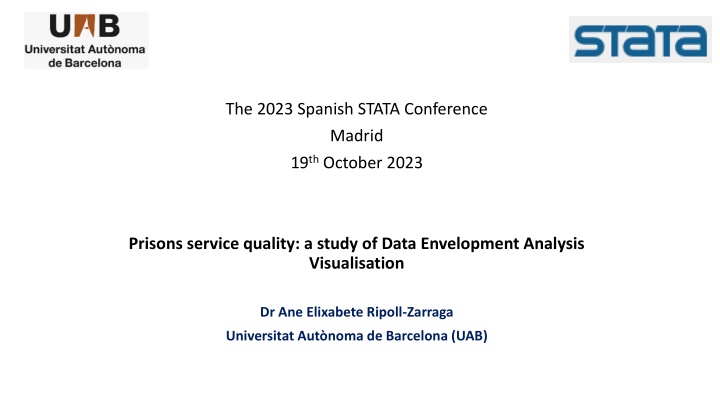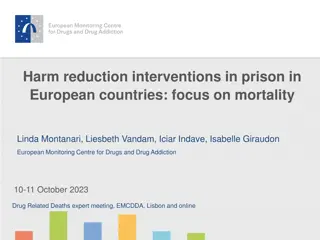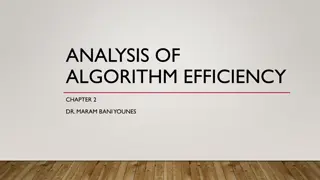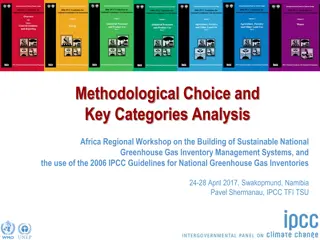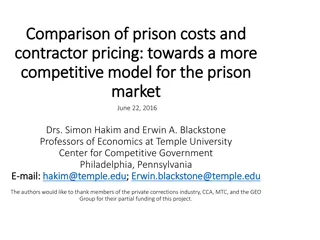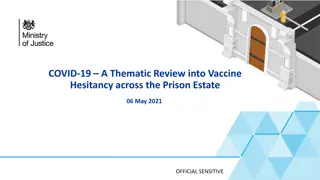Efficiency Methodological Approaches in Prisons Service Quality Study
Exploring efficiency methodologies in analyzing prisons service quality, this study focuses on parametric and non-parametric approaches such as Data Envelopment Analysis (DEA) and Stochastic Frontier Analysis (SFA). It delves into benchmarking techniques, productivity analysis, and the implications of different functional forms and distributions on efficiency scores. The analysis involves methods like Factor Analysis and Cluster Analysis to identify outliers and special performance features within prisons and youth offender institutions.
Uploaded on Sep 11, 2024 | 1 Views
Download Presentation

Please find below an Image/Link to download the presentation.
The content on the website is provided AS IS for your information and personal use only. It may not be sold, licensed, or shared on other websites without obtaining consent from the author.If you encounter any issues during the download, it is possible that the publisher has removed the file from their server.
You are allowed to download the files provided on this website for personal or commercial use, subject to the condition that they are used lawfully. All files are the property of their respective owners.
The content on the website is provided AS IS for your information and personal use only. It may not be sold, licensed, or shared on other websites without obtaining consent from the author.
E N D
Presentation Transcript
The 2023 Spanish STATA Conference Madrid 19thOctober 2023 Prisons service quality: a study of Data Envelopment Analysis Visualisation Dr Ane Elixabete Ripoll-Zarraga Universitat Aut noma de Barcelona (UAB)
Outline Revise Efficiency Methodological Approaches: parametric versusnon- parametric. Methodology DEA-Visualisation: 1. Estimation of Prisons and Youth Offender Institutions (England and Wales, 2020): DEA specifications (one specification is a model with a specific combination of inputs and outputs) 2. Multivariate statistical analysis to identify special performance features, i.e., specialisation, outliers & mavericks: Factor Analysis, Cluster and Pro-Fit. Results Conclusions
Methodological Efficiency Approaches Benchmarking Techniques (Source: based on Von Hirschhausen and Cullmann, 2005) Efficiency/Productivity Analysis Multi- One Dimensional Dimensional Frontier Average Induced Approaches (Index-based numbers) Parametric (deterministic) Non-Parametric Parametric Stochastic Frontier Analysis (SFA) Data Modified Ordinary Least Squares (MOLS) Stochastic DEA (SFEA) Total Factor Productivity (TFP) Ordinary Least Squares (OLS) Corrected Ordinary Least Squares (COLS) Performance Indicators Envelopment Analysis (DEA)
Methodological Efficiency Approaches Data Envelopment Analysis (DEA) Stochastic Frontier Analysis (SFA) Non-Parametric Parametric: production (Max objective) or cost functions (Min costs) Efficiency (??): inputs and outputs contribute to the efficiency score, i.e., it does not capture specialisation. Inefficiency (???): inputs and outputs may not contribute to the overall efficiency score Radial (Farrell, 1957), non-radial (F re and Lovell, 1978) The inefficiency is estimated given the compounded error ( ) (Jondrow et al., 1982; Battese and Coelli, 1988) Non-oriented and oriented models: input orientation (decisions among inputs given the outputs) and output orientation (decisions among outputs given the inputs) ????= ???( ??) ???????= (???) Sensitive to extreme cases (outliers) (Dyson et al., 2001) Unreliable results if inputs or outputs > data (Nyshadham and Rao, 2000), mixing indices and volume measures and other pitfalls (Dyson et al., 2001) Different functional forms (linear, Cobb-Douglas, quadratic, normalised quadratic, translog) Different distributions of the inefficiency term (truncated- normal, half-normal, exponential, gamma) Linear functional form
Methodological Efficiency Approaches Data Envelopment Analysis (DEA) Stochastic Frontier Analysis (SFA) Static analysis (cross-sectional) Additional analysis required (Malmquist Index) Time-invariant inefficiency (? = ??) Pitt and Lee (1981) with half-normal distribution; Battese and Coelli (1988) truncated- normal Time-varying inefficiency (? = ???) Battese and Coelli (1992) truncated-normal, Battese and Coelli (1995) truncated-normal, Kumbhakar (1990) half-normal, Greene (2005a) with the inclusion of time-invariant heterogeneity ( = ?): fixed effects (FE) and random effects (RE), half-normal, truncated-normal and exponential distributions Assumption returns to scale (previously): constant returns to scale-CRS (CCR Model Charnes, Cooper and Rhodes, 1978); variable returns to scale-VRS (BCC Model Banker, Charnes and Cooper, 1984) Returns to scale to be tested Potential use of environmental variables to explain inefficiency (Battese and Coelli, 1995), unit-specific intercepts (Greene, 2005), in one stage analysis (Wang and Schmidt, 2002) Benchmark against the best practice requiring a second stage analysis (sampling distribution): bootstrap or truncated regression (Simar and Wilson, 1998; 2007)
DEA Visualisation: DEA & Multivariate Statistical Techniques Aim estimation of efficiencies of UK and Wales Prisons & YOI (publicly and privately managed) 2020 To confirm the consistency of the structural characteristics of the efficiency scores, i.e., sources of inefficiencies Methodology Serrano-Cinca and Mar- Molinero (2004, 2005) DEA combined with multivariate statistical techniques (visualisation) Advantages: i) The efficiency scores can be ranked even for efficient units ii) The weights-zero problem is overcome iii) Identify sources of inefficiency (consistent) iv) Identify outliers (and mavericks) without removing them Previous applications: Transport Ripoll-Zarraga, A.E. & Mar-Molinero, C. (2020). Exploring the reasons for efficiency in Spanish airports. Transport Policy, 99, 186-202. https://doi.org/10.1016/j.tranpol.2020.08.021 Ripoll-Zarraga, A.E., Portillo, F., and Mar-Molinero, C. (2023). The impact of the Economic Crisis on the efficiency of Spanish airports: A DEA Visualisation analysis. Research in Transportation Business & Management, 100689. https://doi.org/10.1016/j.rtbm.2021.100689 Water Ripoll-Zarraga, A.E. (Forthcoming December 2023). Water provision service: a Visual Study of Data Envelopment Analysis. In (Eds.) Boubaker, S. & Ngo T., Handbook on Data Envelopment Analysis: Applications in Business, Finance, and Sustainability World Scientific.
Multidimensional Scaling (MDS) Kruskai (1960) develops the algorithm (Kruskai & Vish, 1978) Variables=DEA Specifications (n x 1 year) Objects=DMUs (m x 1 year) Mar-Molinero and Serrano-Cinca (2000; 2004; 2005) MDS approach overcomes data inefficiency or lack of relevant information (not disclosures; confidentiality, etc.)
Analysis: Inputs and Outputs Descriptive Statistics (March, 2020)* Source: Minister of Justice (UK) Variable Releases (Number) Negative Drug Tests (Number) Prison Population (Number) Staff (Number of public employees) Capacity (Number prisoners) Obs. 117 118 Mean 448.97 12.35 Std. Dev. 365.19 14.87 Min 1.00 0.00 Max 1,553.00 102.00 Inputs A Prison Population B Staff C Capacity D Investment Outputs 1 Releases 2 Negative Drug Tests 117 102 700.86 357.95 366.98 150.79 101.00 75.00 2,073.00 861.00 118 118 705.81 21,900,000 370.90 11,300,000 96.00 4,280,909 2,106.00 71,800,000 *Except Capacity (December 2020), Investment (2020-2021) Investment ( ) Zero values are substituted by 0.0009 Type of Prisons (2020) Prison Function Local Categories Male Female YOI N/A 32 6 0 D, Female Open, Male YOI Young People B, C, Female Closed, Male Closed YOI Open Prisons 13 2 3 Closed Prisons 50 (B 8, C 42) 3 4 High-Security Prisons Total A, Dispersal 5 0 0 118 100 11 7
Analysis: Inputs and Outputs DEA Specifications Inputs Outputs ABCD12 Traditional DEA model ABCD (Prison Population, Staff, Operational Capacity, Investment) 12 (Releases, Negative Drug Tests) A1, A2, B1, B2, C1, C2,D1, D2, A12, B12, C12, D12 A (Prison Population), B (Staff), C (Operational Capacity), D (Investment) 1 (Releases) AB1, AB2, AB12 AB (Prison Population & Staff) 2 (Negative Drug Tests) AC1, AC2, AC12 AC (Prison Population & Operational Capacity) 12 (Releases & Negative Drug Tests) AD1, AD2, AD12 AD (Prison Population & Investment) BC1, BC2, BC12 BC (Staff & Operational Capacity BD1, BD2, BD12 BD (Staff & Investment) CD1, CD2, CD12 CD (Operational Capacity & Investment) ABC1, ABC2, ABC12 ABC (Prison Population, Staff & Operational Capacity) ABD1, ABD2, ABD12 ABD (Prison Population, Staff & Investment) ACD1, ACD2, ACD12 ACD (Prison Population, Operational Capacity & Investment) BCD1, BCD2, BCD12 BCD (Staff, Operational Capacity & Investment) ABCD1, ABCD2 ABCD (Prison Population, Staff, Operational Capacity & Investment)
Methodology: 1st Stage DEA-BCC Model Following Banker et al. (1984), and in its output-oriented DEA, and the radial model accounting for variable returns to scale ??? ?? ?? ?? ?? ? 0 ?.?. (1) If zero values to be substituted by 0.0009 ? = 1 We obtained 45 DEA specificationns, i.e., 45 different efficiency scores for each DMU DMU Prisons Altcourse Ashfield Askham Grange Aylesbury Bedford Belmarsh Berwyn Birmingham Brinsford Bristol Brixton Bronzefield Spring Hill Warren Hill ABCD12 100.00% 100.00% 100.00% 909.87% 166.68% 221.52% 100.00% 109.84% 172.69% 117.50% 145.74% 100.00% ABCD1 100.00% 100.00% 100.00% 1134.20% 238.91% 449.42% 158.63% 173.49% 178.84% 177.00% 145.74% 100.00% ABCD2 216.57% 100.00% 100.00% 1134.01% 167.02% 251.42% 100.00% 126.89% 631.33% 124.62% 2018.12% 215.46% ABC12 100.00% 169.84% 100.00% 909.87% 166.68% 221.52% 100.00% 110.41% 172.69% 117.61% 163.02% 100.00% ABC1 100.00% 448.18% 103.30% 1134.20% 238.91% 449.42% 170.66% 186.14% 178.84% 177.00% 163.02% 100.00% ABC2 216.57% 174.25% 100.00% 1134.01% 167.02% 251.42% 100.00% 126.89% 652.78% 124.62% 2018.12% 215.46% ABD12 100.00% 100.00% 100.00% 909.87% 166.68% 221.52% 100.00% 109.84% 172.69% 117.50% 148.41% 100.00% ABD1 100.00% 100.00% 100.00% 1134.20% 238.91% 456.28% 158.86% 173.49% 178.84% 177.00% 148.41% 100.00% ABD2 216.57% 100.00% 100.00% 1134.01% 167.02% 251.42% 100.00% 126.89% 631.33% 124.62% 2027.58% 215.46% ACD12 100.00% 596.75% 100.00% 909.87% 175.24% 221.52% 100.00% 109.84% 172.76% 117.50% 169.05% 136.45% 100.00% 1026.59% 100.00% 1230.67% 100.00% 1355.39% 100.00% 1026.59% 100.00% 1230.67% 100.00% 1388.13% 100.00% 1026.59% 100.00% 1230.67% 100.00% 1356.43% 632.51% 1026.59%
Methodology: 2nd Stage i. Factor Analysis (Unrotated & Rotated) Initial Solution Rotated Solution DEA Specifications (45): Variables Component Eigenvalue % of Variance Cumulative % Eigenvalue % of Variance Cumulative % Prisons (118x1=118): Cases 15.75 35.00 35.00 14.39 31.97 31.97 1 Factor Analysis Extraction (PCA): Factors 1 to 4 13.03 28.96 63.96 14.01 31.13 63.10 2 Eigenvalue > 0.70 (criterion applied) 9.10 20.22 84.17 9.13 20.28 83.38 3 Eigenvalue > 1 (Kaiser s criterion) 5.64 12.54 96.71 6.00 13.33 96.71 4 Factor1 < 60% Variability (previous studies>)* 0.54 1.21 97.92 5 Factor1 to 4 = 97% Variability Unrotated: to assess the dimensionality of the data DEA Specifications PC1 PC2 PC3 PC4 Rotated Component Matrix ABCD12 -0.050 0.982 -0.080 0.075 ABCD1 -0.026 0.108 -0.012 0.994 ABCD2 0.991 -0.045 -0.009 -0.018 ABC12 -0.030 0.981 -0.086 0.060 BD1 -0.011 0.028 0.999 -0.005 CD12 -0.057 0.984 0.089 0.055 CD2 0.976 -0.039 -0.006 -0.010 *Gutierrez-Nieto et al (2007); Serrano-Cinca et al. (2016); Sagarra et al. (2017) & Ripoll-Zarraga and Mar-Molinero (2020, 2023)
Methodology: 3rd Mapping Individual Differences Scaling (INDSCAL) INDSCAL Model is based on proximity (Carroll and Chang, 1970) for n periods 1) Proximity (dissimilarity) between two Prisons (DMUs) are calculated per year (i.e., 2020) ? )is caculated based on Euclidian Metric using standardarised Efficiencies 2) Distance (??? 45 ?= ? ??? ?) 2 ??? (??? ?=1 ? is the standardised efficiency of DMU? under the ? DEA specification for year ? Where ??? Assumption: relative distance (position) remains invariable, but the relevance of the dimensions change (external factors) INDSCAL provides: i) common map (invariant); ii) weights (time-related effects, i.e., panel data)
Methodology: 3rd Mapping Individual Differences Scaling (INDSCAL)
Methodology: 3rd Mapping Individual Differences Scaling (INDSCAL) Cluster Analysis Stand.
Methodology: 3rd Mapping Individual Differences Scaling (INDSCAL) Cluster Analysis
Methodology: 4th Stage ProFit Biplots (Gower and Hand, 1996) a technique known as Property Fitting (ProFit). i) The mathematical method used to represent variables and specifications in the same space is described in Mar-Molinero and Mingers (2007). ii) Each DEA specification is represented by a vector starting at the origin of coordinates and pointing in the direction in which a particular feature of the data increases. For each ? DEA Specification and Year ? a regression Y (? DEA Specification)=f(Coordinates of DMU ? in Common Map) Y (? DEA Specification)=f(?1,?2, ??) Assumption: for more than one period the location of a DMU related to a pair of dimensions remains constant Average for each DMU ? and ? DEA Specification (n regression models for n periods) Restriction: Dimensions are standardised, therefore we can compare Ys ?? ?? = ,? = 1 .? 2 ?=1 ??? 2
Methodology: ProFit Y (? = 45 DEA Specification)=f(?1,?2, ??=7) 45 regressions Beta1* Beta2* Beta3* Beta4* R2 DEASpecifications ABCD12 -0.37 7.24 -0.59 0.55 0.978 ABCD1 -275.31 1,137.30 -128.70 10,427.22 1.000 ABCD2 39,531,277.38 -1,795,474.39 -373,404.74 -734,727.66 0.984 ABC12 -0.23 7.50 -0.65 0.46 0.975 ABC1 -279.98 1,183.50 -134.44 10,429.61 1.000 ABC2 57,537,084.97 -2,566,206.75 -508,886.15 -990,098.05 0.997 D2 101,306,734.18 -4,084,018.14 -623,525.32 -1,107,618.22 0.963
Methodology: ProFit End point vectors
Methodology: ProFit End point vectors
Conclusions The in-efficiency depends on the Inputs-Outputs used by the researcher, but is this a true and fair view? DEA Visualisation helps to identify intrinsic characteristics of the database, not visible at human-eye, by using Pro-Fit the results of the analysis can be presented graphically Identification of a similar group of DMUs (good/bad practices) To identify weak/strengths of DMUs activity: potential diversification/specialisation To visualise mavericks/outliers without having to remove them from the sample Overcomes weight-zero problem It can be use with panel data (Ripoll-Zarraga et al. 2023) Limitations Production frontier shifts are not mathematically considered Use of rations in DEA (Dyson et al. 2001): work in progress
Thank you for your attention Dr Ane Elixabete Ripoll-Zarraga Senior Lecturer Operations & Audit Auditor-Consultant Linkedin ResearchGate https://www.researchgate.net/profile/Ane-Ripoll-Zarraga
